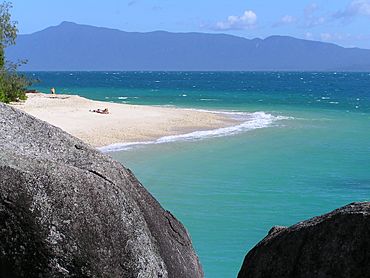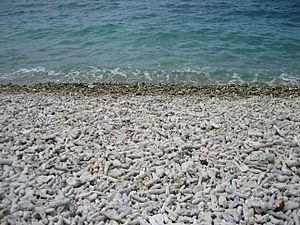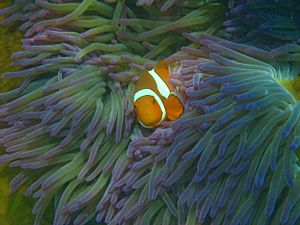Fitzroy Island National Park facts for kids
Quick facts for kids Fitzroy Island National ParkQueensland |
|
|---|---|
|
IUCN Category II (National Park)
|
|

Beach on Fitzroy Island
|
|
| Nearest town or city | Cairns |
| Established | 1939 |
| Area | 3.24 (part of Fitzroy Island) |
| Managing authorities | Queensland Parks and Wildlife Service |
| Website | Fitzroy Island National Park |
| See also | Protected areas of Queensland |
Fitzroy Island National Park is a special protected area in Far North Queensland, Australia. It covers all of Fitzroy Island. This beautiful island is located about 22 kilometers (14 miles) east of Cairns on the mainland.
The traditional owners of Fitzroy Island are the Kobaburra people. They are part of the Gungganyji language group. The island is very important to their culture and history.
As a National Park, the island's nature and cultural sites are protected by law. This means some parts of the island are off-limits to visitors. Most people stay on the calm western side. Here you can find the jetty, a resort, and great places for snorkeling.
Contents
About Fitzroy Island
Fitzroy Island is a special type of island called a continental island. This means it was once connected to the mainland. It became an island when sea levels rose after the last ice age. This happened about 10,000 years ago. The rising water covered the flat land that connected the island to what is now Cape Grafton.
Over many thousands of years, amazing coral reefs have grown in the bays. You can find these reefs on the protected western side of the island. The island also has lush rainforests along its shores.
Island History
People have used Fitzroy Island in many ways throughout history. The Gurabana Gungandji people have always known the island. They used it for hunting and fishing. They even have myths about how the island was formed.
In 1778, Lieutenant James Cook named the island. He named it after the family of the Duke of Grafton. The Duke was the British Prime Minister when Cook's ship, HMB Endeavour, began its journey.
In the 1800s, people used the island for collecting pearls and sea cucumbers. Later, in 1876, a special station was built there. It was used for people arriving from China on their way to the Palmer River Goldfields. Today, there is still a research station on Welcome Bay. This station studies giant clams.
The island has also been used for other things. In the early 1900s, it was a mission. During World War II, it had artillery guns to protect the area. More recently, it has become a popular tourist resort.
Fitzroy Island has also been home to lighthouses. These lights helped warn ships about the reefs. They guided ships through the Grafton Passage. A small automatic light is still active on Little Fitzroy Island. This tiny island is just off the north-east point.
An old, inactive lighthouse sits on the point above. You can visit it by walking along a special trail.
Amazing Animals
Fitzroy Island is quite isolated. This means it has a unique habitat. There are not many large mammals here. The main predators on the island are reptiles. You can find different types of pythons. These include brown and green tree pythons.
You might also see monitor lizards and Major skinks. The Major skink is very common. You will likely see them often if you walk the trails. There are no venomous snakes on the island. However, python bites can sometimes get infected.
Fun Things to Do
Walking Trails
There are great walking tracks on Fitzroy Island. One trail takes you to the northern end of the island. You can see the lighthouse on the north-west point. This lighthouse looks out over Little Fitzroy Island.
The trail also goes to the island's highest point. From the top, you get amazing 360-degree views. You can see the surrounding reefs and Cape Grafton. On a clear day, you might even see the Frankland Islands to the south. The trail then leads back down to the resort.
Snorkeling Adventures
Snorkeling is a fantastic activity at Fitzroy Island. The coral reef is close to the shore in many places. At the northern end of Welcome Bay, it starts near 'Bird Rock'. It goes almost all the way to the jetty. There is a small gap for boats.
The reef starts again near the rocks at the southern end of the beach. It then goes around the corner to Nudey Beach. Along this part, the reef is very close to the shore. You can step right into it!
The snorkeling at Fitzroy Island is truly wonderful. Sometimes the water might not be super clear, especially after rough weather. But the coral is beautiful, and there are many different kinds of fish. You can spot clownfish (Amphiprion percula), just like Nemo! Other anemonefish are also common. You might also see Parrotfish and wrasses. Green sea turtles often swim in the bay too.
It is very unlikely to see box jellyfish at Fitzroy Island. This is because the island is 4 kilometers (2.5 miles) from the mainland. However, other stinging jellyfish have been found there sometimes. It's always good to be aware.
The Island Resort
Fitzroy Island Resort is located on Welcome Bay. You can reach the resort by a 60-minute ferry ride from Cairns. The island is surrounded by a reef system. This reef is part of the amazing Great Barrier Reef Marine Park.
See also
 In Spanish: Parque nacional Isla Fitzroy para niños
In Spanish: Parque nacional Isla Fitzroy para niños







